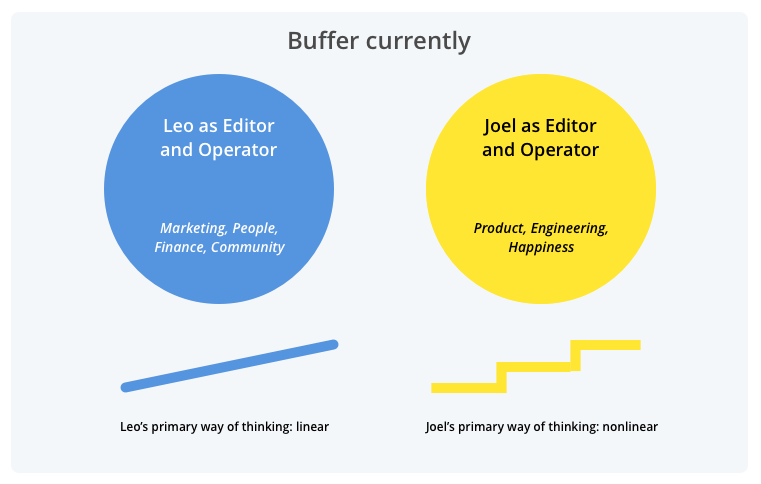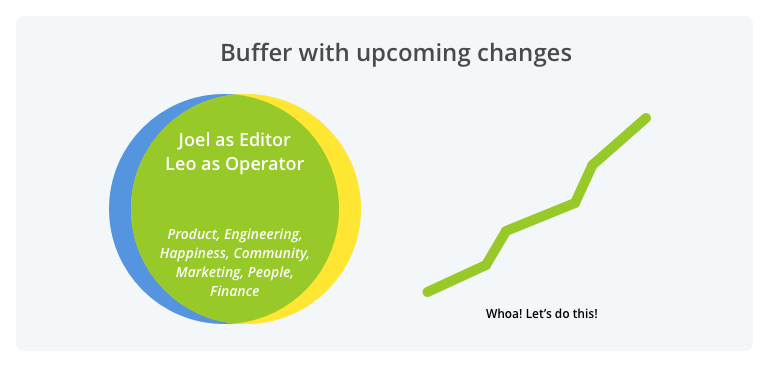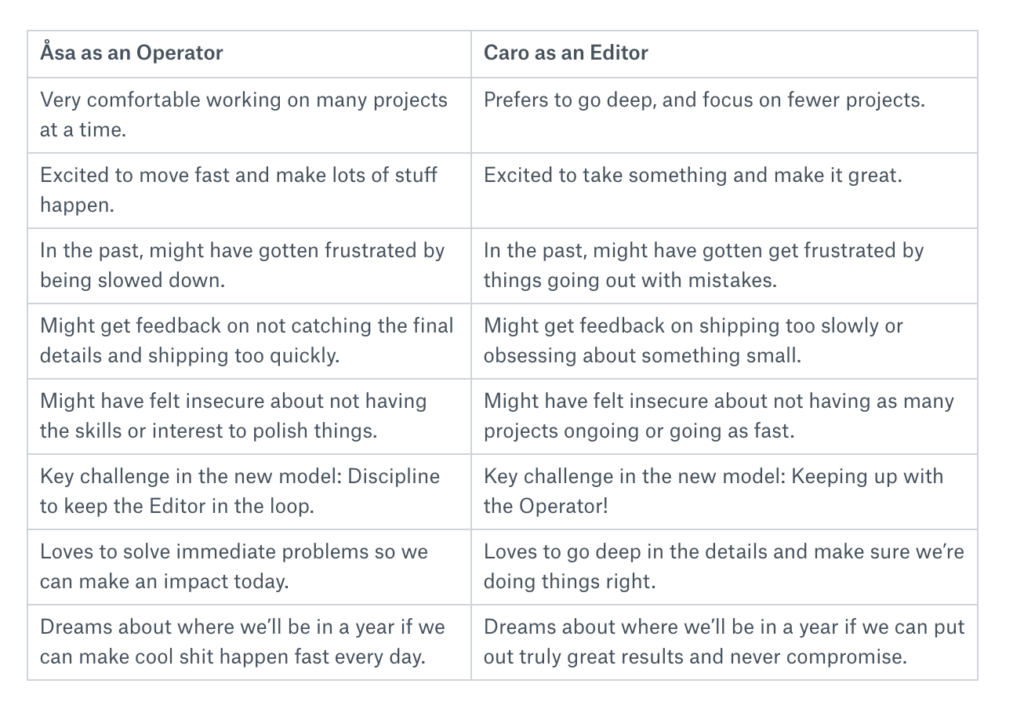What combination of strengths help a team thrive?
We’ve written before about the “bias toward action” mindset that we believe creates a great fit on the Buffer team, and we’re always experimenting, evolving and fine-tuning the ways we work together.
Recently, we’ve turned toward a new model we’re calling “Editor/Operator.” At its core, it’s about harnessing the complementary strengths of two different work styles: One focused on vision/details/editing and the other on execution/performance/operations.
In sum, the Operator gets us going fast. The Editor keeps us on the right road!
In the past, many of us at Buffer have often tried to work on our own weaknesses and cover both of these mindsets individually.
For this experiment, we instead lean heavily into our own strengths and supplement our weaknesses to help us keep creating a unique company.
We’d love to share more about this model and how we’re using it at Buffer.
The Editor/Operator model
In the last year, Buffer co-founders Joel and Leo have both been “doing it all,” both being editors (focusing on vision, the why and details) and operators (focusing on setting goals, creating results and moving fast).
But after lots of discussions, they realized they have very different strengths.
Joel makes his biggest contributions through his creativity, vision, ideas and problem-solving capabilities. He’s incredibly detail-oriented and has a super high quality bar for himself and for Buffer. He cares deeply about the experience we provide, for customers and for ourselves and future team members.
At the same time, he’s less excited about executing processes and creating those results. Being a manager or operator of day-to-day processes isn’t his strength.
Leo, on the other hand, thrives on the opposite end of the spectrum. His strengths are in execution of projects and getting results.
Leo feels less called to focus on the specific details of a project, though he appreciates Joel’s insight on big-picture vision to come up with the best direction forward.
Here’s a diagram that describes how they were working before we adopted the new model:

They both noticed that something really cool happened when they worked together on projects that were able to benefit from the combination of their approaches: They made great progress, twice as fast.
“That’s when we find ourselves having outcomes we both feel excited to celebrate,” Joel says.
What if we could find a way to tap into both of their core areas of strength and maximize them?
The Editor/Operator model is our current solution to this challenge, and we’ve reorganized Buffer a bit to help those who identify strongly as an Editor or an Operator to lean into those specialties.
Starting with our founders: While Leo leans further into his “operator” nature, Joel has moved towards his CEO role resembling much more of a company-wide editor than a manager.
“It is quite common for a CEO to act in this way, there are many of CEOs I look up to who operate in this way, such as Mark Zuckerberg, Larry Page or Jack Dorsey,” Joel says. “And for this to really work, I’ve read several times that it relies on working with a strong set of operational managers.”

Of course, not everyone is on an extreme of this spectrum. But we were surprised at how much this model resonated with so many of us. It made so much sense to the team that we’ve adapted it in other areas of Buffer as well.
On the Engineering side, Sunil feels called to the editor side and Niel is taking on the operator role as Director of Product Engineering.
On the happiness team, Carolyn has moved into an editor role while Åsa focuses on more of an operator role.
Carolyn even put together this cool chart to explain the differences between the two roles even further:

What work looks like with the Editor/Operator model
So what changes on the day-to-day level when you’re working with both Editors and Operators? We’re still figuring it out, but there are a few things we’ve noticed so far.
A key change so far has been that the Operator takes on most of the regular one-on-one mentoring to help us create continuity and accountability across all areas.
With this change, editors are less tied to any one project and instead are available to edit and provide advice on many projects and ideas.
With our co-founders as an Editor/Operator duo:
- Leo makes it a goal to maximize bringing Joel’s reflections, detail and care to Buffer.
- Joel now has ability to both focus on the details and go big-picture by setting vision and direction for Buffer.
Here are a few examples of what some of Joel’s work as an Editor can look like:
- Discuss big picture OKRs (objectives and key results) at the start of a quarter to set direction.
- Set down and articulate our vision and mission for Buffer.
- Give feedback on the angle we’re planning for a blog post or press announcement.
- Help product and engineering teams find the best minimal feature-set for an MVP.
- Dig into the smallest details of an interface to give users an incredible experience.
- Brainstorm a vision for how we can do some truly unique things in the customer service space.
- Do a session getting into the details with a small team on the next iteration of our salary formula, to include better support for a wider range of experience levels and multiple career paths.
- Review a feature before we roll it out to 50% of users.
- Digging into the toughest questions around inclusivity with the Inclusivity Guild.
- Helping solve a tricky customer situation that needs extra love and care.
The ideal outcome? A high bar for everything we do, while at the same time picking up our pace significantly.
Over to you!
This realization has been a really neat step and iteration at Buffer. Of course, a binary structure like this has its limitations. Another framework we’ve been exploring most recently is the Adizes Methodology of producers, administrators, entrepreneurs and integrators. It’s fascinating to learn about the many different ways we can reflect on our strengths and work better together.
Editor/operator is an early experiment in progress, and we’re keen to keep learning more and see if this can help us achieve more, faster.
Do you resonate more with the editor or operator mindset? We’d love to hear your thoughts in the comments!
Try Buffer for free
190,000+ creators, small businesses, and marketers use Buffer to grow their audiences every month.



